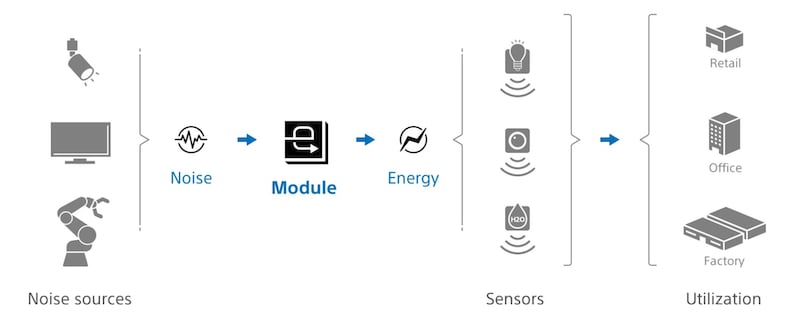Sony’s Energy Harvester Draws Power From Electromagnetic Wave Noise
Sony Semiconductor Solutions has devised a device that uses stray EM waves that already exist in the environment to power IoT devices.
If the human eye could detect the full electromagnetic (EM) spectrum, we would see the world around us replete with EM waves. While many of these EM waves are from intentional sources, like radio and cellular signals, a good portion of them also radiate from electronic devices in our homes and workplaces inadvertently.

SSS' new device harvests ambient EM waves and uses them to power IoT devices. Image used courtesy of Sony Semiconductor Solutions
What if a module could recapture these unwanted emissions and use them to power other devices? Sony’s semiconductor arm, Sony Semiconductor Solutions (SSS), explored this concept in a newly announced chip that harvests energy from EM wave noise.
SSS Harvests EM Wave Noise
SSS designed the new module to provide a stable and continuous power supply for low-power devices like IoT sensing nodes and communication equipment. It does this by employing a unique architecture that integrates a specialized antenna and a high-efficiency rectifier circuit.

Sony’s new module comes in a 7 mm x 7 mm x 1.2 mm footprint. Image used courtesy of Sony Semiconductor Solutions
The antenna captures electromagnetic wave noise from the electronic devices' metal components that emit these waves. The rectifier circuit then converts the captured electromagnetic wave noise into a direct current with enhanced electricity conversion efficiency—though SSS has not yet revealed metrics about the module's exact efficiency. The system is tuned to capture waves ranging in frequency from several Hz to 100 MHz.
One of the standout features of this module is its compact design, which enables flexible installation. Sony claims the device can be integrated into a wide range of environments, from industrial settings like factories to commercial spaces and homes.
EM Waves Are Everywhere
SSS' new device relies on the assumption that EM waves are abundant in most environments. Electronic circuits produce EM waves as a byproduct because of Ampere’s law, which states that as the current in a conductor changes with time, it induces a magnetic field around the conductor. Essentially every circuit today operates with such time-varying currents.

A radiated emissions scan of a system with a 10-MHz clock frequency. Image used courtesy of Arturo Mediano/In Compliance Magazine
Consider a modern processor that consists of billions of transistors, each of which turns on and off billions of times per second. With each on/off transition, the transistor abruptly draws current to charge a capacitive node or cuts off the flow of current and discharges a node. In either case, the current draw in a digital device is non-linear and time-varying, often dictated by the clock frequency of the system. The same can be said for almost any other electronic circuit, even if it's not on the same scale or complexity as a processor.
This principle causes electronic circuits to emit unwanted EM waves (or EM wave noise) from devices.
A Sustainable Power Source for the IoT Ecosystem
While SSS has not released more technical details about the chip, the group claims the module is a step toward a more sustainable IoT ecosystem. As the number of IoT devices grows, so does the challenge of powering them; traditional batteries are not only limited in lifespan but also pose environmental concerns.
SSS' energy-harvesting module represents an alternative that is both sustainable and efficient. By converting electromagnetic wave noise—which is generally considered waste—into a valuable resource, the module could introduce a paradigm shift in how we think about energy harvesting and waste management in electronic devices.







